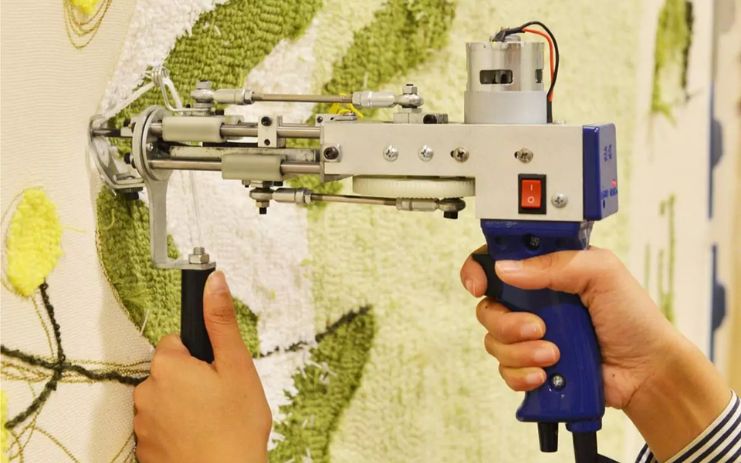Tufting is an artistic activity and a popular craft that allows you to create the most inspiring and unique handcrafted rugs. This rug tufting process can either be manually or automatically handled via a tufting gun. When you begin with a tufting hobby, the possibilities for creating rugs are endless in terms of designs, shapes, and materials.
If you are an amateur interested in exploring rug tufting ideas for how to tuft a rug by hand, you are at the right place. In this blog by Rug Dubai, you will discover the detailed process of rug tufting for your personalized endeavors and begin your journey like a pro!
Understanding The Tufting’s Basics

While a tufting gun is a go-to tool and a highly efficient approach to making a handmade rug, alternative methods can achieve the desired results. If you want tomake a rug without a tufting gun, this guide is for you. Tufting is basically a process of punching yarn for pile creation through a backing material, providing a thick, soft, and stable surface.
Gather Essential Equipment
- Punching Needle
- Backing Material
- Pile Yarn
- Framing Material
- Marker Or Chalk
- Scissor
- Projector
1
Take Precise Measurements

Regarding rug tufting, the first and foremost step is accurate measurements. For beginners, it is suggested that you go with small-sized rugs. Take precise details of the length and width that will further make the backing to create a pile of yarn. The backing will serve as the base for your tufted rug.
2
Choose Your Preferred Design

The next step is to select a design that can be created on a canvas. Stretch the canvas across the frame and create the design you want. The design can be created using a projector that allows clear vision to simulate quickly. However, you must flip your image using a projector to avoid an upside-down drawing.
3
Prepare Backing Material

After you finish the design selection, the backing preparation setup will come. To go with the perfect tufting, stretch your selected canvas or cotton backing material and precisely secure it over the frame. Use the chalk or marker to highlight the area per your design and rug size magnitude.
4
Start With Tufting

Now that you have outlined the area pick the desired thread and take your punching needle. Begin tufting from one corner of the design and work along with proper strategy and dimension. Use a hand-held punching needle to pass through the fabric up and down to create the yarn loops on the surface. For a unique and stylish touch, consider using cotton rugs Dubai for a soft and durable finish to your design.
5
Cut Or Un-cut Pile

For tufting, you have two approaches to go with: cut or looped. In loop tufting, you insert the needle through the fabric, create the small loops on the front, and cut the yarn close to the loop. While in cut tufting, you insert the needle into the fabric from the back, leave the knot on the surface, and cut the pile yarn close to the knot.
6
Finishing Touches

Keep the fabric tight on the frame to ensure even stitches, and go with a uniform yarn direction. Once you are done with tufting, trim the excess pile yarn beyond the rug surface and secure the edges to prevent unraveling using glue. Also, you can add a backing to the rug’s underside by stitching or fabric glue for durability.
To Conclude
Rug tufting is an artistic and rewarding activity that allows you to unfold your creativity and create personalized floor coverings for any setting. For those unfamiliar with this tufting work, it is crucial to learn the basics. First, gather all the requisite materials and start with design preparation on your tufting canvas.
After choosing the tufting thread, you can begin the process using a tufting gun. Make sure to handle the process with utmost precision and care, ending with backing attachment and finishing touches. By following the instructions in this guide and practicing them, one can master the art of tufting and create a unique style.
FAQs | Frequently Asked Questions
Rug tufting is not simple nor a complicated task but it does require real struggle at first. You can learn it thoroughly with continuous practice and take proper time to acknowledge how it is done with perfection.
Yes! Initiating this hobby is quite expensive as you have to invest in certain tools and materials. But it costs you a one-time expense for tools and framings, later you just need to purchase the pile yarn fibers and backings. However, project scale can also affect the cost factor.
Tufting rugs by hand is quite expensive process as it requires human effort, specialized tools, and high quality materials. In addition to that, the production process is labor-intensive and time-consuming depending on the size and number of rugs per project.
Well, it entirely depends on the type and quality of fiber materials used in the tufting process. Plus, the effort and skills of weavers make the difference. On average, these floor coverings can last for more than 12-18 years.
Cotton and polyester are popular and durable options for rug tufting. Besides these widely used materials, muslin, canvas, and other woven materials can also be used in tufting these floor coverings. For a textured and rustic look, another exceptional choice is burlap.


